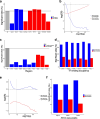Developmentally dynamic changes in DNA methylation in the human pancreas
- PMID: 38831310
- PMCID: PMC11145889
- DOI: 10.1186/s12864-024-10450-8
Developmentally dynamic changes in DNA methylation in the human pancreas
Abstract
Development of the human pancreas requires the precise temporal control of gene expression via epigenetic mechanisms and the binding of key transcription factors. We quantified genome-wide patterns of DNA methylation in human fetal pancreatic samples from donors aged 6 to 21 post-conception weeks. We found dramatic changes in DNA methylation across pancreas development, with > 21% of sites characterized as developmental differentially methylated positions (dDMPs) including many annotated to genes associated with monogenic diabetes. An analysis of DNA methylation in postnatal pancreas tissue showed that the dramatic temporal changes in DNA methylation occurring in the developing pancreas are largely limited to the prenatal period. Significant differences in DNA methylation were observed between males and females at a number of autosomal sites, with a small proportion of sites showing sex-specific DNA methylation trajectories across pancreas development. Pancreas dDMPs were not distributed equally across the genome and were depleted in regulatory domains characterized by open chromatin and the binding of known pancreatic development transcription factors. Finally, we compared our pancreas dDMPs to previous findings from the human brain, identifying evidence for tissue-specific developmental changes in DNA methylation. This study represents the first systematic exploration of DNA methylation patterns during human fetal pancreas development and confirms the prenatal period as a time of major epigenomic plasticity.
Keywords: Brain; DNA methylation; Development; Fetal; Monogenic diabetes; Neonatal diabetes; Pancreas; Sex differences.
© 2024. The Author(s).
Conflict of interest statement
The authors declare no competing interests.
Figures







Similar articles
-
CpG sites with continuously increasing or decreasing methylation from early to late human fetal brain development.Gene. 2016 Oct 30;592(1):110-118. doi: 10.1016/j.gene.2016.07.058. Epub 2016 Jul 25. Gene. 2016. PMID: 27468947
-
Methylomic trajectories across human fetal brain development.Genome Res. 2015 Mar;25(3):338-52. doi: 10.1101/gr.180273.114. Epub 2015 Feb 3. Genome Res. 2015. PMID: 25650246 Free PMC article.
-
DNA Methylation Landscapes of Human Fetal Development.PLoS Genet. 2015 Oct 22;11(10):e1005583. doi: 10.1371/journal.pgen.1005583. eCollection 2015 Oct. PLoS Genet. 2015. PMID: 26492326 Free PMC article.
-
Characterizing the dynamic and functional DNA methylation landscape in the developing human cortex.Epigenetics. 2021 Jan;16(1):1-13. doi: 10.1080/15592294.2020.1786304. Epub 2020 Jul 15. Epigenetics. 2021. PMID: 32602773 Free PMC article.
-
Fundamentals of DNA methylation in development.Pediatr Res. 2024 Dec 10. doi: 10.1038/s41390-024-03674-7. Online ahead of print. Pediatr Res. 2024. PMID: 39658604 Review.
Cited by
-
Dynamic visualization of DNA methylation in cell cycle genes during iPSC cardiac differentiation.Epigenomics. 2024 Dec-Dec;16(23-24):1407-1414. doi: 10.1080/17501911.2024.2430171. Epub 2024 Nov 27. Epigenomics. 2024. PMID: 39601042
References
MeSH terms
LinkOut - more resources
Full Text Sources
Molecular Biology Databases

